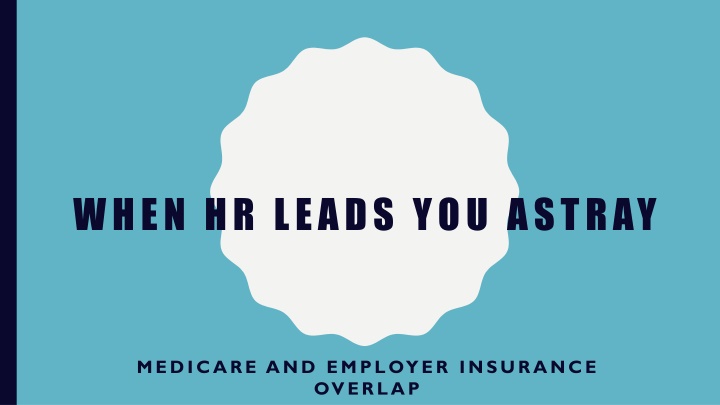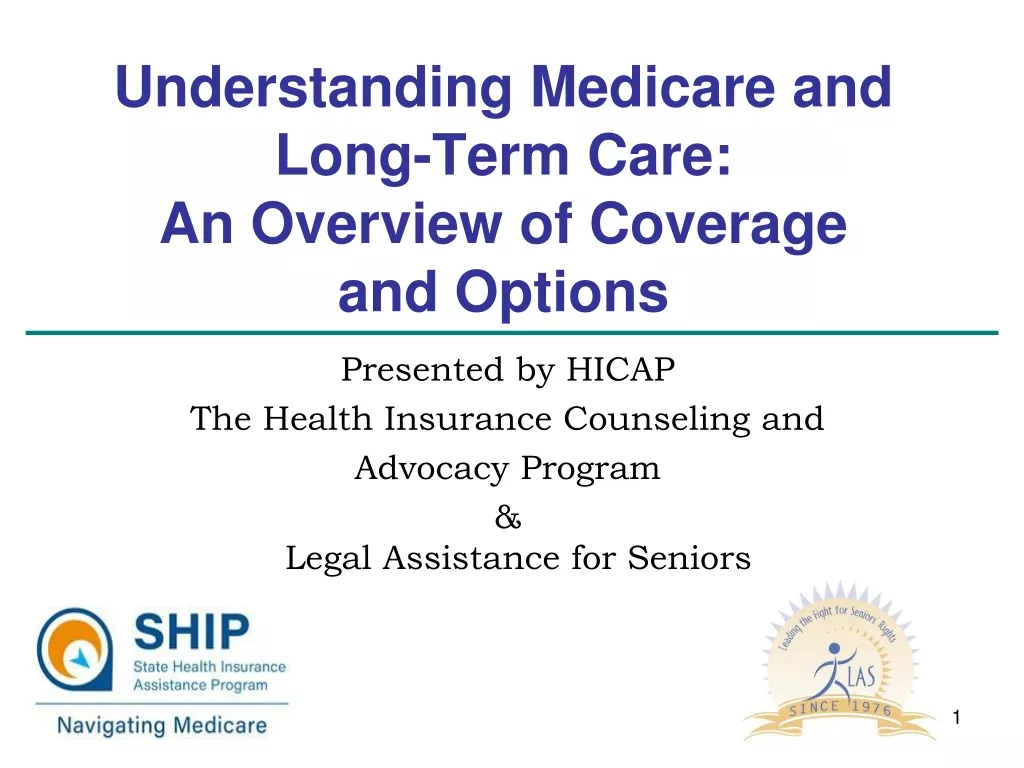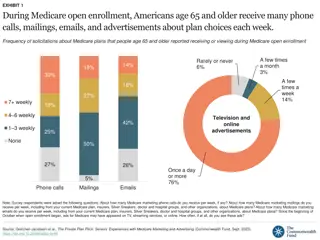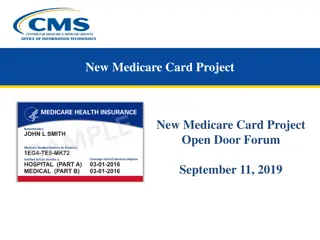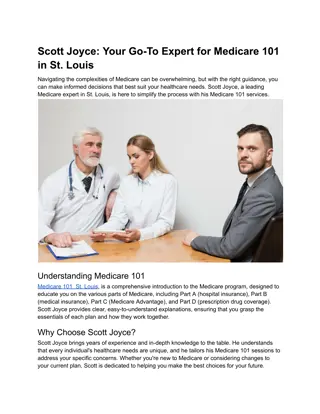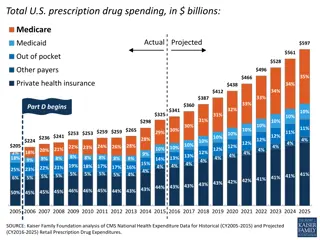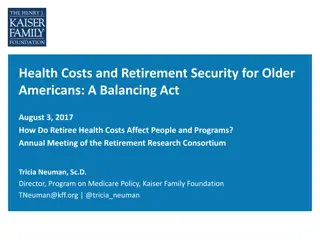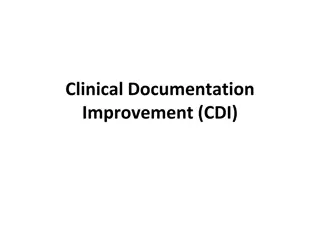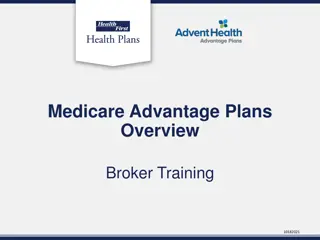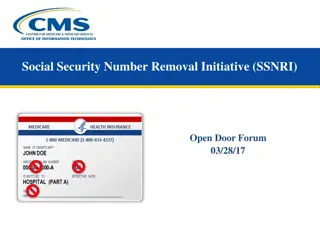Navigating Medicare and Employer Insurance Overlap
Individuals near Medicare eligibility while working or retired often seek HR guidance. However, HR may lack expertise on Medicare interaction, leading to gaps in coverage, penalties, and limitations. To avoid these issues, it's crucial to understand the client's employment status, Medicare eligibility, sources of information, and coordination of benefits between primary and secondary payers.
Download Presentation

Please find below an Image/Link to download the presentation.
The content on the website is provided AS IS for your information and personal use only. It may not be sold, licensed, or shared on other websites without obtaining consent from the author.If you encounter any issues during the download, it is possible that the publisher has removed the file from their server.
You are allowed to download the files provided on this website for personal or commercial use, subject to the condition that they are used lawfully. All files are the property of their respective owners.
The content on the website is provided AS IS for your information and personal use only. It may not be sold, licensed, or shared on other websites without obtaining consent from the author.
E N D
Presentation Transcript
WHEN HR LEADS YOU ASTRAY MEDICARE AND EMPLOYER INSURANCE OVERLAP
SCOPE Individuals/couples who are working/retired and near Medicare eligibility Medicare Parts A & B Assume you re familiar with: Part A & B initial enrollment, general enrollment, and special enrollment periods (IEP, GEP, and SEPs) Part B late enrollment penalties (LEPs)
THE ISSUE When people are employed or nearing retirement at the same time as approaching Medicare eligibility, it makes sense for them to go to their Human Resources department to ask questions about insurance coverage Although knowledgeable in their own policies and procedures, HR departments are not always the best resources for information about Medicare, or about how Medicare interacts with employer and retiree coverage Often HR departments do not fully understand the consequences of delaying Medicare enrollment There is no recourse against HR departments
WHAT WERE TRYING TO AVOID Gaps in coverage Late enrollment penalties Unexpected limits to coverage
WHAT YOULL NEED TO KNOW Is the client actively employed or retired? Is the client a spouse of someone who is actively employed or retired? Is the client on COBRA? How many employees does the employer employ? Is the client eligible for or about to become eligible for Medicare? - Is the nature of client s Medicare eligibility due to age or disability? What is the client s source of information (HR, SSA, 1-800- MEDICARE)?
COORDINATION OF BENEFITS PRIMARY VS. SECONDARY PAYERS Coordination of Benefits: sharing of costs and coverage by two or more health plans When another entity has the responsibility of paying before Medicare, Medicare is the Secondary Payer WHY IT MATTERS: If a client is eligible for but not enrolled in Medicare but Medicare is primary payer, employer/retiree insurance can deny or limit coverage, leaving client with the bill
IMPORTANT If a newly-eligible Medicare beneficiary s existing health coverage will pay only secondary to Medicare benefits, the person must enroll in Medicare Parts A & B or risk having little to no health coverage It s eligibility (not enrollment) that counts! When a person s existing coverage will pay primary to Medicare, an individual retains the option to enroll solely in part A and delay enrollment in Part B
ACTIVELY EMPLOYED Whether an employer plan pays primary or secondary to Medicare depends on 2 things: 1. why a person is eligible for Medicare (age or disability), and 2. the size of the employer
EMPLOYED AGE 65 FEWER THAN 20 EMPLOYEES Who Pays First? Medicare pays first if you re eligible for Medicare, whether you re enrolled in Medicare or not Employer pays second LEP: No Part B penalties while you are working and up to 8 months after you retire or lose employer coverage SEP: Qualify for SEP up to 8 months after you retire or lose employer coverage MORE THAN 20 EMPLOYEES Who Pays First? Employer pays first Medicare pays second LEP: No Part B penalties while you are working and up to 8 months after you retire or lose employer coverage SEP: Qualify for SEP up to 8 months after you retire or lose employer coverage
EMPLOYED UNDER 65 & DISABLED FEWER THAN 100 EMPLOYEES MORE THAN 100 EMPLOYEES Who Pays First? Who Pays First? Medicare pays first once you are eligible for Medicare, whether you are enrolled in Medicare or not Employer pays second LEP: No Part B penalties while you are working and up to 8 months after you retire or lose employer coverage SEP: Qualify for SEP up to 8 months after you retire or lose employer coverage Employer pays first Medicare pays second LEP: No Part B penalties while you are working and up to 8 months after you retire or lose employer coverage SEP: Qualify for SEP up to 8 months after you retire or lose employer coverage
ACTIVE EMPLOYEES WHO PAYS FIRST? AGE 65 AND OLDER UNDER 65 AND DISABLED More than 20 employees Fewer than 20 employees More than 100 employees Fewer than 100 employees Medicare Secondary Primary Medicare Secondary Primary Employer coverage Primary Secondary Employer coverage Primary Secondary
RETIRED Who Pays First? Generally, as soon as you retire, retiree insurance becomes secondary to Medicare LEP: you will incur late enrollment penalties while you are receiving retiree coverage and not on Medicare, if eligible for Medicare SEP: Retiree coverage is not considered current employer coverage, and thus does not qualify for SEP
SPOUSES SPOUSES OF ACTIVE EMPLOYEES SPOUSES OF RETIREES Who Pays First? may have less coverage than their retired spouse treated in the same way as the active employees Plan-specific LEP: Spouses receiving active employee coverage from their spouses do not incur Part B penalties Retirees do not have to be treated the same as the retired person SEP: Qualify for SEP up to 8 months after spouse retires or loses employer coverage
COBRA Who Pays First? Medicare pays primary COBRA pays secondary LEP: you will incur late enrollment penalties while you are on COBRA and not on Medicare, if eligible for Medicare SEP: COBRA is not considered current employer coverage, and thus does not qualify for SEP
RETIRED, SPOUSES AND COBRA WHO PAYS FIRST? Retired person Spouse of Retired person See plan Spouse of Active Employee Same as active employee Same as active employee COBRA Medicare Primary Primary Other coverage Secondary See plan Secondary
PART B LATE ENROLLMENT PENALTIES AND SPECIAL ENROLLMENT PERIODS STATUS Active Employee receiving employer coverage Spouse of Active Employee receiving employer coverage Retiree Spouse of Retiree COBRA LEP No LEP SEP SEP No LEP SEP LEP LEP LEP No SEP No SEP No SEP
STILL IMPORTANT If a newly-eligible Medicare beneficiary s existing health coverage will pay only secondary to Medicare benefits, the person must enroll in Medicare Parts A & B or risk having little to no health coverage It s eligibility that counts!
WHEN SPOUSES OF ACTIVE EMPLOYEES HAVE ACCESS TO OTHER INSURANCE It is legal in Wisconsin for active employee coverage of one spouse to impose a premium surcharge if that spouse has access to other insurance but declines to take it This can come in the form of other insurance offered through the spouse s employment This cannot come in the form of Medicare because you cannot treat an over-65 spouse differently than you would an under-65 spouse (charging extra because of Medicare eligibility under active employee coverage is age discrimination)
SURCHARGE EXAMPLE SURCHARGE OK SURCHARGE NOT OK Jan, 65, is an administrative assistant at a legal office and Don, 66, is a groundskeeper for a local technical college. Both Jan and Don have employer insurance. Don declines his employer s health insurance because Jan s is better. Jan s employer imposes a premium surcharge because Don has other employer insurance available to him that he is declining to take. Tammy, 65, is a nurse at a local hospital and Chuck, 66, is retired. Chuck is eligible for Medicare, but declines it because he gets good coverage from Tammy s active employment. Tammy s insurance imposes a premium surcharge because Chuck is eligible for Medicare but has declined to take it.
MEDICARE CARVE-OUT Applies to Retirees and Spouses of Retirees Only Employer insurance can limit what it pays based on what Medicare would pay for a Medicare-eligible retiree or spouse of a retiree. This is called a Medicare Carve-Out. Does not Apply to Active Employees and Spouses of Active Employees Employer insurance cannot apply this limit to active employees or spouses of active employees. Generally, if the employer offers coverage to spouses and has 20 or more employees, it must offer the same coverage to spouses 65 and older that it offers to spouses under 65
RECOURSE AVAILABLE AGAINST FEDERAL EMPLOYEES/AGENTS ONLY Equitable Relief POMS HI 00805.170 Must prove Person s failure to enroll in Part B was unintentional, inadvertent or erroneous, and Was a result of error, misrepresentation or inaction of a federal employee or any person authorized by the federal government to act in its behalf 1-800-MEDICARE counselor SSA caseworker Customer service representative for a Medicare private health plan
PREVENTATIVE STEPS If clients are thinking about turning down Part B or enrolling in only Part A they should call SSA and confirm they can defer enrollment without penalty Explain the type and source of other insurance and other circumstances in as much detail as possible Make sure to write down Who you speak to The date/time of the conversation What was said Follow the same guidelines if you contact Medicare
RECOURSE AGAINST HUMAN RESOURCES Employers must ensure that your plan does not discriminate against employees and employee s spouses age 65 and over, people who suffer from permanent kidney failure, and disabled Medicare beneficiaries for whom Medicare is secondary payer (Again, does not apply to retirees!) Otherwise, there is NO RECOURSE against HR departments that give bad advice regarding Medicare enrollment!
MARGIE & DUKE Margie is 63 years old and works in the sales department of a local business with about 30 employees. Margie s husband, Duke (67), worked at the same business in the shipping department. When Duke turned 65, he was still employed and talked to his HR Department about what to do regarding Medicare. They told him there was no reason to take Medicare because of his employer insurance. He declined Parts A & B. When Duke retired at age 66, he again talked to HR, who advised him to stay on Margie s employer insurance because it would be better than retiree insurance. Duke again asked about Medicare, but HR told him not to worry because he d be covered under Margie s active employee coverage.
MARGIE & DUKE Duke comes and asks you if he s made a mistake by declining Medicare, what do you tell him?
MARGIE & DUKE, CONTINUED Duke suffers a stroke 2 months before his 68thbirthday. He is hospitalized, treated, and then transferred to a skilled nursing facility for rehabilitation. When Duke starts receiving medical bills for his services, he is shocked to learn that his wife s active employee insurance is only covering what Medicare would cover, because he is eligible for Medicare.
MARGIE & DUKE Is this correct? Can his wife s active employee coverage limit Duke s coverage based on what Medicare would pay, regardless of whether he s on Medicare or not?
SANDRA Sandra, age 64, receives health insurance through her employment as a supervisor at a local paper mill, which employs about 80 people. She turns 65 in September of 2016, and plans to retire by the end of the year. She wants to take her employer s retiree coverage when she retires. When she talks with her HR department about her retirement, she asks about Medicare because she s already received the paperwork in the mail. HR tells her that it s up to her she can take Medicare or not, but she will still be receiving good coverage with the retiree coverage. Sandra decides to take Medicare Part A because it s free, but declines Part B, thinking she will start it sometime after she retires. She retires in December of 2016.
SANDRA In March, 2017 - the following year after her retirement (and 6 months after her 65thbirthday) - Sandra is diagnosed with high blood pressure and has many doctor s visits while her medication is getting worked out. When Sandra s medical bills start to come, she is shocked to learn that her retiree coverage is limited to what Medicare would pay, even though she s not on Medicare. Sandra goes to her HR department, who points to the Medicare carve-out plan in the policy.
SANDRA Is it legal for Sandra s retiree coverage to limit its coverage in this way?
SANDRA Scared about the high costs, Sandra decides she should enroll in Medicare Part B immediately. She goes to her local SSA office to apply. She is told that because she missed her IEP and is outside the GEP, she has to wait until January of 2018 to apply, and then her Medicare won t start until July, 2018. She is also told that she will pay a penalty for the time she was eligible for Medicare but didn t take it. Thinking this must be some kind of mistake, she comes to you seeking advice.
SANDRA Is SSA correct? If SSA had been correct, what recourse would Sandra have?
SUMMARY Questions to ask: Is the client actively employed or retired? Is the client a spouse of someone who is actively employed or retired? Is the client on COBRA? How many employees does the employer employ? Does Evidence of Coverage include a Medicare carve-out provision? If so, is it being legally applied? Does Evidence of Coverage impose a surcharge? If so, is it being legally applied? Is the client eligible for or about to become eligible for Medicare? If so, based on age or disability? What is the client s source of information?
